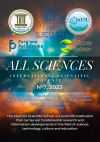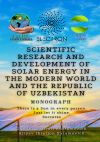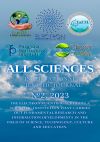Текст книги "All sciences. №9, 2023. International Scientific Journal"

Автор книги: Temurbek Bekmirzayev
Жанр: Математика, Наука и Образование
Возрастные ограничения: +12
сообщить о неприемлемом содержимом
Текущая страница: 1 (всего у книги 9 страниц) [доступный отрывок для чтения: 2 страниц]
All sciences. №9, 2023
International Scientific Journal
Authors: Aliyev Ibratjon Xatamovich, Otajonov Salim Madraximovich, Alimov Nodir Esonaliyevich, Botirov Qodir Abdullayevich, Yakubova Nigora Mamadiyorovna, Bekmirzayev Temurbek Nasrullayevich, Musajonov Yusufjon Ravshanovich, Sattorov Nuriddin Sotvoldiyevich, Jarkinboyev Shoxboz Baxodirovich, Vavilova Ekaterina Aleksandrovna, Forikova Nigoraxon Inomjonovna, Azamov Valijon
Editor-in-Chief Ibratjon Xatamovich Aliyev
Illustrator Ibratjon Xatamovich Aliyev
Illustrator Sultonali Mukaramovich Abduraxmonov
Illustrator Obbozjon Xokimovich Qo'ldashov
Cover design Ibratjon Xatamovich Aliyev
Cover design Ra'noxon Mukaramovna Aliyeva
Acting scientific supervisor Sultonali Mukaramovich Abduraxmonov
Economic manager Farruh Murodjonovich Sharofutdinov
Proofreader Gulnoza Muxtarovna Sobirova
Proofreader Abdurasul Abdusoliyevich Ergashev
© Ibratjon Xatamovich Aliyev, 2024
© Salim Madraximovich Otajonov, 2024
© Nodir Esonaliyevich Alimov, 2024
© Qodir Abdullayevich Botirov, 2024
© Nigora Mamadiyorovna Yakubova, 2024
© Temurbek Nasrullayevich Bekmirzayev, 2024
© Yusufjon Ravshanovich Musajonov, 2024
© Nuriddin Sotvoldiyevich Sattorov, 2024
© Shoxboz Baxodirovich Jarkinboyev, 2024
© Ekaterina Aleksandrovna Vavilova, 2024
© Nigoraxon Inomjonovna Forikova, 2024
© Valijon Azamov, 2024
ISBN 978-5-0062-1035-6
Created with Ridero smart publishing system
PHYSICAL AND MATHEMATICAL SCIENCES
CURRENT RESEARCH IN THE DIRECTION OF STUDYING THE LARGEST PLANET IN THE SOLAR SYSTEM – JUPITER
UDC 523.45
Aliyev Ibratjon Xatamovich3rd year student of the Faculty of Mathematics and Computer Science of Ferghana State University
Ferghana State University, Ferghana, Uzbekistan
Annotation. This study analyzes modern achievements of science and technology on the way to explore the largest and most massive object in the Solar System, except for its star, the planet Jupiter. Much attention is paid to the analysis of its internal structure and the environment prevailing there, along with a parallel analysis of the possibilities of technologies for exploring the planet under specified physical conditions.
Keywords: Jupiter planet, gas giant, environment, physical and mathematical modeling, research, analysis.
Аннотация. В настоящем исследовании проводиться анализ современных достижений науки и техники на пути исследования самого большого и массивного объекта в Солнечной системы, кроме её звезды – планеты Юпитер. Большое внимание уделяется анализу его внутренней структуры и царящей там среды, наряду с параллельным анализом возможностей технологий для исследования планеты при обозначенных физических условиях.
Ключевые слова: планета Юпитер, газовый гигант, среда, физико-математическое моделирование, исследование, анализ.
The planet Jupiter, which is the second largest, after the Sun in terms of size and volume of objects in the Solar System, appears as a rather interesting object to study, along with a variety of space objects. So, it was this planet, discovered by the brilliant scientist Galileo Galilei, that became one of the key reasons for the collapse of the geocentric theory, as well as the clearest proof that not all objects in the system revolve around the Earth or the Sun, which in turn struck a blow towards the heliocentric system. Jupiter has a huge number of very different satellites and today more than 80 satellites are known, but the first of them were discovered precisely the so – called Galileo satellites, named by his German colleague – Ganymede, Europa, Io and Calisto.
Jupiter is a gas giant, unlike other planets with a solid surface, surrounded by a large thick atmosphere. This was also the reason that this planet is home to the largest hurricane in the entire Solar System, the size of planet Earth, called the «Big Red Spot» and which has been going on for hundreds of years and besides, the wind speed in it reaches 650 km/h or 350 knots. It is also worth noting that only in its small diameter, because it has the shape of an ellipsoid, it is approximately equal to the Earth, and its larger diameter is relatively larger than the diameter of the Earth.
It is interesting to establish the initial connection with the planet directly, namely, the process of transferring from the optical part of the spectrum to the radio wave, one can see the radiation of the planet’s magnetic field formed in a powerful magnetosphere. So, the first information about this radiation was received from Pioneer-10 on March 12, 1973, after which all models were equipped with a powerful safety system against strong electromagnetic radiation, but the next obstacle is a powerful atmosphere, even more significant in its danger than the danger of the electromagnetic background.
For the first time, the Galileo spacecraft succeeded in penetrating the planet’s atmosphere on December 8, 1995, when its expedition was launched and for 8 years this device has been transmitting information about the analysis of both the planet itself and satellites. So, its first satellite Io is a very tectonic space object with a large number of volcanoes and slightly larger than the Moon, in contrast to the calm and snowy Europe, under which there is supposed to be a huge ocean. There are suggestions that real life can live in this liquid icy water.
But neither Io nor Europa have a magnetic field, as Ganymede is the largest satellite not only among the moons of Jupiter, but also among all the satellites in the Solar System. Returning to the atmosphere of Jupiter itself, it is worth believing that his research was carried out by Galileo, or rather by his atmospheric probe, which turned on at an altitude of 350,000 kilometers above the clouds of Jupiter and after 6 hours at a speed of 48 km/s he touched the atmosphere of the planet and spent 57 seconds only on the braking process.
Its sensors detect a sharply increasing temperature value, which reaches values of 16,000 degrees Celsius. The exhaust parachute helps by reducing the speed to 120 m / s and this happens only in the upper layers of the atmosphere, which was higher in magnitude only at the beginning, and in small subsequent layers is equal to the Earth’s atmosphere. The second main parachute also opens, reducing the speed to 27 m / s, which also reduces the temperature, after which the most important information about the structure of Jupiter’s atmosphere is transmitted within an hour, the overall temperature is also measured, a huge number of lightning is recorded, which are very common in such dense clouds of the planet. In addition, data on the energy received from the Sun is recorded, with a comparison of the energy, the emitter of which is the core of the planet.
At a depth of 180 km, at a temperature of 150 degrees Celsius and a pressure of 2,300,000 Gpa, which is comparable to an atmospheric pressure of 101,325 Pa in 22.7 atmospheres, the radio transmitter overheats and the device stops transmitting information. However, it continues its flight for several hours, the temperature and pressure begin to rise, leading to the fact that it eventually melts and evaporates in the vast atmosphere of the planet, turning into a part of it.
Galileo ended its existence, having received the same fate after 8 years of incessant service. But it is worth saying that this is only the beginning of the journey and the time will come when it will be possible to talk about creating more powerful devices equipped with new nuclear engines using thermonuclear or resonant nuclear reactions. The energy obtained from such energy sources will be sufficient to penetrate to a greater depth, supporting a thicker shell structure capable of withstanding higher atmospheric pressures, while continuing to penetrate into the deep layers of the atmosphere. In addition, paying attention to the chemical composition of Jupiter, which is dominated by hydrogen, nitrogen and some other gaseous compounds, there is a huge ocean of liquid hydrogen, which subsequently turns into a solid core.
There is also a further analysis of the planet, along with consideration of the possibility of participating in the role of a passenger in a spacecraft of this type – a human. Full-fledged installations could be developed that can receive energy from lightning, even if necessary, the number of which is simply huge, not to mention ultrafast winds, which can already be used not for wind generators, but for full-fledged ion engines or, more precisely, ion generators. Among all the above, the real challenge for human civilization, like the conquest of Mount Everest, remains the conquest of the «Big Red Spot» until it has transformed its existence, because if we compare even the data obtained at the beginning of the last century, the power and size of the largest hurricane in the system decrease every time. From the above it can be seen that achieving the set results is quite realistic and possible, which in turn will bring human civilization and its capabilities to a new level.
The literature used1. Dr. David R. Williams. Jupiter Fact Sheet. NASA. 2007.
2. P. Kenneth Seidelmann et al. Report of the IAU/IAG Working Group on cartographic coordinates and rotational elements. 2006 // Celestial Mechanics and Dynamical Astronomy: journal – Springer Nature, 2007. – Vol. 98, No. 3. – P. 155—180.
3. National Aeronautics and Space Administration. Probe Nephelometer. // характеристики космического аппарата. – NASA/JPL. 1983. – Iss. 6.
4. Анна Сдобина. Ты не пройдёшь! Кто ловит космических странников на пути к Земле // Наука и жизнь, 2022,;4. – С. 10—16.
5. Tristan Guillot, Daniel Gautier. Giant Planets. – 2009-12-10.
6. Elkins-Tanton, Linda T. Jupiter and Saturn. – New York: Chelsea House, 2006. – ISNB 0-8160-5196-8.
7. Guillot, T.; Stevenson, D. J.; Hubbard, W. B.; Saumon, D. Chapter 3: The Interior of Jupiter // Jupiter: The Planet, Satellites and Magnetosphere (англ.) / Bagenal, F.; Dowling, T. E.; McKinnon, W. B. – Кембриджский университет Press, 2004. – ISBN 0521818087.
8. Bodenheimer, P. Calculations of the early evolution of Jupiter (англ.) // Icarus. – Elsevier, 1974. – Vol. 23. – P. 319. – doi:10.1016/0019—1035 (74) 90050—5
9. Hubbard, W. B.; Burrows, A.; Lunine, J. I. Theory of Giant Planets. – С. 112—115.
10. Георгий Бурба «Оазисы экзопланет». // Журнал «Вокруг света» №9 (2792), Сентябрь 2006
11. Guillot, Tristan. Interiors of Giant Planets Inside and Outside the Solar System (англ.) // Science: journal. – 1999. – Vol. 286, no. 5437. – P. 72—77. – doi:10.1126/science.286.5437.72. – PMID 10506563.
12. Burrows, A.; Hubbard, W. B.; Saumon, D.; Lunine, J. I. An expanded set of brown dwarf and very low mass star models (англ.) // The Astrophysical Journal: journal. – IOP Publishing, 1993. – Vol. 406, no. 1. – P. 158—171. – doi:10.1086/172427.
13. Rory Barnes & Thomas Quinn. THE (IN) STABILITY OF PLANETARY SYSTEMS (англ.). – Seattle, WA: Dept. of Astronomy, University of Washington, JANUARY 12, 2004. – P. 30. – doi:10.1086/421321. – arXiv: astro-ph/0401171.
14. Roy, A. E. & Ovenden, M. W. On the occurrence of commensurable mean motions in the solar system (англ.). – Monthly Notices of the Royal Astronomical Society. – 232 p. – (SAO/NASA Astrophysics Data System (ADS)).
15. Мюррей К., Дермотт С. Динамика Солнечной системы. – Физматлит, 2010. – 588 с. – 500 экз. – ISBN 987-5-9221-1121-8.
16. Карл Саган «Космос: Эволюция Вселенной, жизни и цивилизации», – СПб: Амфора, 2008, С. 58—61. ISBN 978-5-367-00829-6
17. Atreya, S. K.; Mahaffy, P. R.; Niemann, H. B. et al. Composition and origin of the atmosphere of Jupiter – an update, and implications for the extrasolar giant planets (англ.) // Planetary and Space Sciences: journal. – 2003. – Vol. 51. – P. 105—112. – doi:10.1016/S0032—0633 (02) 00144—7.
18. Sagan, C. et al. Polycyclic aromatic hydrocarbons in the atmospheres of Titan and Jupiter (англ.) // The Astrophysical Journal: рец. науч. журнал. – IOP Publishing, 1993. – Vol. 414, no. 1. – P. 399—405. – ISSN 0004—637X. – doi:10.1086/173086. – Bibcode: 1993ApJ…414..399S.
19. Ingersoll, A.P.; Dowling, T.E.; Gierasch, P.J.; et al. (2004). «Dynamics of Jupiter’s Atmosphere» (PDF). In Bagenal, F.; Dowling, T.E.; McKinnon, W.B. (ed.). Jupiter: The Planet, Satellites and Magnetosphere. Cambridge: Cambridge University Press. ISBN 0-521-81808-7..
20. Miller, Steve; Aylword, Alan; and Milliword, George. Giant Planet Ionospheres and Thermospheres: the Importance of Ion-Neutral Coupling (англ.) // Space Sci.Rev.: journal. – 2005. – Vol. 116. – P. 319—343. – doi:10.1007/s11214-005-1960-4..
21. Е. П. Левитан. Астрономия: Учебник для 11 кл. общеобразовательных учреждений. – 9-е изд. – М.: Просвещение, 2004. – ISBN 5-09-013370-0..
STUDY OF THE CONTROL PROPERTIES OF POLYCRYSTALLINE STRUCTURES BASED ON SILICON AND CADMIUM TELLURIDE
UDC 544.22
Salim Madrahimovich OtajonovDoctor of Physical and Mathematical Sciences, Professor of the Department of «Professional Education» of the Faculty of Physics and Technology of Fergana State University
Alimov Nodir Esonalievich
Doctor of Philosophy in Physical and Mathematical Sciences, Lecturer at the Department of Physics, Faculty of Physics and Technology, Ferghana State University
Botirov Qodir Abdullayevich
Lecturer of the Department of «Professional Education» of the Faculty of Physics and Technology of Ferghana State University
Ferghana State University, Ferghana, Uzbekistan
Annotation. In this paper, the photoelectric properties of CdTe – SiO2 – Si heterostructures are investigated. For the first time, the possibility of controlling the spectrum of short – circuit current and photo-EMF using an integrated charge in a dielectric (SiO2) has been demonstrated. It was found that with an increase in the corona discharge potential, the spectra will mix into the short – wavelength regions of the spectrum from 0.93 to 1.5 eV, while the activation energy of the deep level of 0.73 eV changes significantly and this change occurs due to the Poole-Frenkel effect. It is found that the electric field strength in the vicinity of the defect is ε = 105 V/cm.
Keywords: photoconductivity, PHOTOEMF, spectral distribution of photosensitivity, short-circuit current, asymmetry of barriers, surface photo-EMF, deep levels, impurity photoconductivity, corona discharge.
Аннотация. В данной работе исследованы фотоэлектрические свойства гетероструктур на основе CdTe – SiO2 – Si. Впервые продемонстрирована возможность управления спектра тока короткого замыкания и фото – ЭДС при помощи встроенного заряда в диэлектрике (SiO2). Установлено, что с увеличением потенциала коронного разряда спектры смешается в коротковолновые области спектра от 0,93 до 1,5 эВ, при этом существенно изменяется энергии активации глубокого уровня 0,73 эВ и это изменение возникает за счёт эффекта Пула – Френкеля. Найдено, напряжённость электрического поля в окрестности дефекта ε = 105 В/см.
Ключевые слова: фотопроводимость, фото-ЭДС, спектральное распределение фоточувствительности, ток короткого замыкания, асимметрия барьеров, поверхностная фото-ЭДС, глубокие уровни, примесная фотопроводимость, коронный разряд.
IntroductionThe development of micro – nano electronics and new technological possibilities for the manufacture of complex semiconductor structures stimulate further study of new optical and photovoltaic phenomena in active film elements.
Currently, oxides and nitrides of semiconductors and semiconductor films grown on their surfaces are widely used in the manufacture of multichannel photovoltaic converters and other active elements of microelectronics circuits, and in particular, optoelectronics. In this case, it is possible to obtain high-quality and dielectric layers of semiconductors with deep levels. At the same time, it is easier and cheaper to use polycrystalline films sprayed on amorphous substrates rather than epitaxial ones.
CdTe semiconductor films are an important material for the creation of photodetector devices based on heterostructures operating in the near (up to 3 microns) and far (8—14 microns) The IR range. It is of interest to obtain heterostructures based on photosensitive layers with different types of conductivity. A promising p-type material doped with silver and copper, which give an acceptor level in the forbidden zone with a long lifetime of non-main charge carriers [1—14].
The aim of the work is to study new photovoltaic properties of active CdTe thin films and heterostructures in a system with SiO2-Si under conditions of specific external influences.
The results of experimental studies of the photovoltaic properties of textures from sprayed layers of CdTe – SiO2 – Si, etc., allow the development of new devices based on polycrystalline films with controlled properties.
Below we investigate the photosensitivity of the CdTe – SiO2 – Si structure, which can be used, for example, as a metal – silicon nitride oxide semiconductor (MNP) – a transistor with a polarized dielectric [1,2], which allows electrical rewriting of information.
Experimental resultsPolycrystalline (grain sizes are 0.05—0.1 microns) CdTe films were obtained on the surface of SiO2 – Si. CdTe and Ag and Cu impurities evaporated in a vacuum of 10—5 mmHg from separate evaporators onto the heated oxidized surface of Si. The relative arrangement of the layers of the CdTe – SiO2 – Si structure and the ohmic contacts to them is schematically shown in Fig.1. In such a structure, photosensitivity is controlled by external influences, such as an electric field or corona discharge, which change the built-in field in the dielectric. In this case, we have a «reverse» field – effect transistor of the CdTe – SiO2 – Si type, when the control charge is located under the semiconductor layer, and its surface remains open.

Fig.1 The relative position of the layers of the CdTe – SiO2 – Si structure. 1,2 – contacts; 3 – filtering contacts.
Currently, electrification using a corona discharge is the main method of sensitizing photovoltaic layers in industrial electrography [3].
An experimental setup was used for corona electrification of the studied structures, the block diagram of which is presented in [4]. Electrification occurs due to deposition of positive or negative ions in a corona discharge on the surface of the layer. Corona discharge occurs if the voltage between the metallized surface of the Al layer and the electrode exceeds 6 kV, when the field embedded in the structure reached 100 V. The spectra of the short – circuit current charged in this way in the CdTe – SiO2 – Si structure were studied depending on the magnitude of the external corona discharge and showed that in the static mode a shift of the spectra to the short-wave region is observed (Fig.2). It turned out that in such a structure, the photosensitivity of the layer can be controlled by the action of an external corona discharge potential (using the «field effect» method), which, as it turns out below, induce embedded electric charges in the dielectric.
In Fig.2. The spectral dependences of the short-circuit current (Icz) of the CdTe layer for various values of the corona discharge intensity, which were carried out by contact (2) and electric probe contact (3) to the surface of the CdTe semiconductor, are presented. It can be seen that in the absence of external influences in the Icz (v) spectra, an inversion of the Icz sign is observed in the vicinity of the light quantum energy value equal to hν= 1.21eV (curve 1) the inclusion of the surface corona discharge potential between the CdTe layer and silicon leads to a significant change in the spectral sensitivity of the short-circuit current (Icz). When the surface potential changes within its value from 0 to 100 V, the inversion position of the short-circuit current sign will mix into the short-wave region of the spectrum. In this case, the maximum photosensitivity of the Icz will be mixed into the short-wavelength region of the spectrum in the range from 0.93 eV to 1.5 eV. The position of the maximum value of the Icz increases by more than 1000 times at 70 angstems (curve 3).

Fig.2. Spectral dependences of the Icz for the CdTe-SiO2-Si structure on the magnitude of the corona discharge potential: jcr = 0 V (curve 1), 40 V (2),70 V (3). The inset shows the photosensitivity spectra of the impurity region of light absorption on a logarithmic scale.
Правообладателям!
Данное произведение размещено по согласованию с ООО "ЛитРес" (20% исходного текста). Если размещение книги нарушает чьи-либо права, то сообщите об этом.Читателям!
Оплатили, но не знаете что делать дальше?








































